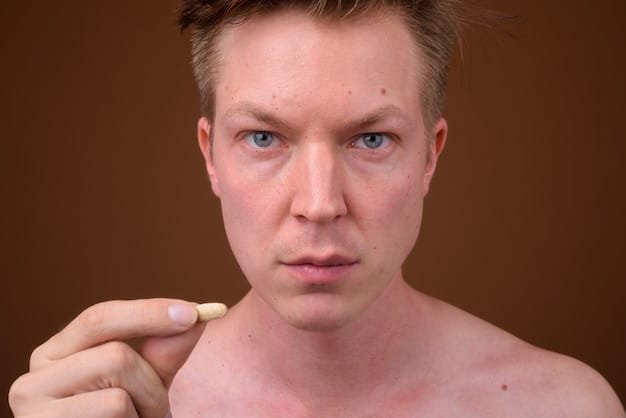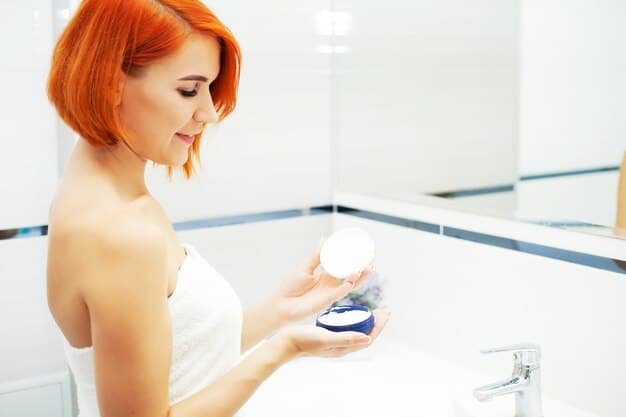Reduce Acne by 40% in 2 Months: Salicylic Acid Guide

Reduce acne breakouts effectively in just two months by strategically incorporating salicylic acid into your skincare routine, coupled with lifestyle adjustments, for clearer and healthier skin.
Want to reduce acne breakouts by 40% in 2 months? Salicylic acid might be the game-changer you’re looking for. This guide will walk you through how to use it effectively, combining skincare with lifestyle adjustments for clearer skin.
Understanding Acne and Salicylic Acid
Acne is a common skin condition affecting millions. Salicylic acid is a powerful tool in combating it.
But what exactly is acne, and how does salicylic acid work to clear it up?
What Causes Acne?
Acne forms when hair follicles become clogged with oil and dead skin cells. Here’s a quick breakdown:
- Excess Sebum: Overproduction of oil leads to clogged pores.
- Dead Skin Cells: These clog pores, trapping oil and bacteria.
- Bacteria (P. acnes): This bacteria multiplies in clogged pores, causing inflammation.
- Inflammation: Leads to redness, swelling, and pimples.
Different types of acne include blackheads (open comedones), whiteheads (closed comedones), papules (small, red bumps), pustules (pimples with pus), nodules (large, painful bumps under the skin), and cysts (deep, pus-filled lesions).
How Salicylic Acid Works
Salicylic acid is a beta-hydroxy acid (BHA) that exfoliates the skin. Here are its key actions:
- Exfoliation: It dissolves dead skin cells on the surface.
- Pore Cleansing: Penetrates pores to dissolve oil and debris.
- Anti-Inflammatory: Reduces redness and swelling.
- Comedolytic: Helps prevent the formation of new blackheads and whiteheads.
By addressing these causes, salicylic acid can significantly reduce acne breakouts.
In summary, understanding the origins of acne and the targeted actions of salicylic acid sets the stage for effectively managing and reducing breakouts.

Choosing the Right Salicylic Acid Product
With numerous products available, it’s essential to select the right one for your skin type and acne severity. Different formulations offer varying strengths and benefits.
From cleansers to spot treatments, understanding the options will help you build an effective routine.
Cleansers
Salicylic acid cleansers are a gentle way to incorporate the ingredient into your daily routine. They help remove excess oil and dead skin cells. Look for cleansers that contain:
- Concentration: 0.5% to 2% salicylic acid
- Formulation: Gel or foam cleansers are generally suitable for most skin types.
- Usage: Use once or twice daily, depending on your skin’s tolerance.
For example, CeraVe Renewing SA Cleanser is a popular choice.
Toners
Toners can deliver an extra dose of salicylic acid after cleansing. Key considerations include:
- Concentration: Usually around 0.5% to 1% salicylic acid.
- Ingredients: Look for alcohol-free toners to avoid excessive drying.
- Application: Apply with a cotton pad after cleansing, focusing on acne-prone areas.
Paula’s Choice Skin Perfecting 2% BHA Liquid Exfoliant is a highly-rated option.
Spot Treatments
For targeted treatment of individual pimples, spot treatments are ideal. These usually have a higher concentration of salicylic acid.
- Concentration: 1% to 2% salicylic acid.
- Application: Apply a small amount directly to the pimple.
- Frequency: Once or twice daily, as needed.
For instance, Neutrogena Rapid Clear Acne Spot Treatment contains 2% salicylic acid.
In summary, when choosing a salicylic acid product, consider your skin type, acne severity, and the concentration of the active ingredient for optimal results.
Building Your Skincare Routine
An effective skincare routine incorporating salicylic acid involves several steps tailored to your skin’s needs. Consistency is key to seeing results. Let’s explore how to craft a routine for maximum impact.
A well-structured routine will ensure that you’re not only treating acne but also maintaining overall skin health.
Morning Routine
Start your day with a gentle routine to prep your skin. Important steps include:
- Cleansing: Use a salicylic acid cleanser to remove oil and impurities.
- Toning: Apply an alcohol-free toner to balance your skin’s pH.
- Moisturizing: Hydrate your skin with a lightweight, non-comedogenic moisturizer.
- Sunscreen: Protect your skin with a broad-spectrum SPF 30 or higher.
Evening Routine
Your evening routine should focus on deeply cleansing and treating acne. Key steps are:
- Double Cleansing: First, remove makeup with a gentle cleanser, then use a salicylic acid cleanser.
- Treatment: Apply a salicylic acid spot treatment to any active pimples.
Additional Tips
- Patch Test: Before using any new product, perform a patch test to check for sensitivity.
- Consistency: Stick to your routine for at least 6-8 weeks to see noticeable results.
By incorporating these steps into your daily routine, you can maximize the effectiveness of salicylic acid and achieve clearer skin.
Lifestyle Adjustments for Clearer Skin

Skincare isn’t just about topical treatments. Lifestyle adjustments play a crucial role in managing acne and enhancing the effects of salicylic acid. Diet, sleep, and stress management all impact skin health. Let’s explore these key factors.
These changes can complement your skincare routine and support overall well-being.
Diet
Certain foods can trigger acne breakouts. Consider these dietary adjustments:
- Limit Sugary Foods: High sugar intake can increase inflammation.
- Reduce Dairy: Some studies link dairy to increased acne.
- Incorporate Anti-Inflammatory Foods: Include fruits, vegetables, and omega-3 fatty acids.
Sleep
Adequate sleep is essential for skin repair and overall health. Aim for 7-9 hours of quality sleep per night. Here’s why:
- Reduces Stress Hormones: Lack of sleep can increase cortisol levels, leading to breakouts.
- Supports Skin Repair: Skin regenerates during sleep.
- Enhances Overall Health: Proper sleep boosts your immune system.
Stress Management
Stress can exacerbate acne. Effective stress management techniques can make a big difference. Techniques include:
- Mindfulness Meditation: Practice daily meditation to reduce stress levels.
- Regular Exercise: Physical activity helps lower stress hormones.
- Hobbies: Engaging in activities you enjoy can reduce stress.
Implementing these lifestyle adjustments can enhance your skincare efforts and contribute to clearer, healthier skin.
What to Expect and Potential Side Effects
While salicylic acid is effective, it’s important to be aware of potential side effects and what to expect during the initial stages of treatment. Understanding these aspects will help you use the product safely and effectively.
Being informed will prevent unnecessary concerns and ensure you adjust your routine as needed.
Initial Purging
Some people experience a “purging” phase when starting salicylic acid. This is where it might seem like your acne is getting worse before it gets better. Purging occurs because:
- Accelerated Exfoliation: Salicylic acid brings underlying clogs to the surface.
- Temporary Breakouts: Existing comedones may surface more quickly.
Purging usually lasts for a few weeks and is a sign that the product is working. Be patient and continue with your routine.
Potential Side Effects
Salicylic acid can cause some side effects, especially when first starting treatment. Common side effects include:
- Dryness: Salicylic acid can dry out the skin. Use a good moisturizer.
- Irritation: Redness and peeling may occur. Reduce frequency if needed.
- Sun Sensitivity: Salicylic acid can make your skin more sensitive to the sun. Always use sunscreen.
Tips for Managing Side Effects
To minimize side effects, consider these tips:
- Start Slowly: Begin with a low concentration and gradually increase.
- Use a Moisturizer: Apply a non-comedogenic moisturizer to combat dryness.
- Apply Sunscreen: Protect your skin from sun exposure.
In summary, while using salicylic acid, be prepared for potential purging and side effects, and adjust your routine to minimize discomfort and protect your skin.
Tracking Your Progress and Adjusting Your Routine
Monitoring your skin’s progress is essential for gauging the effectiveness of your salicylic acid regimen. Regular tracking and adjustments can optimize your routine for the best outcome. Let’s look at how to effectively monitor your progress and adapt your strategies.
This approach ensures continuous improvement and keeps your skin healthy.
Keep a Skin Diary
Documenting your skin’s condition can provide valuable insights. Include the following in your diary:
- Daily Skin Condition: Note any changes in acne, redness, or dryness.
- Products Used: Record all products used each day.
- Diet and Lifestyle: Note any significant changes in diet, sleep, or stress levels.
This data can help you identify triggers and assess the impact of different variables.
Visual Documentation
Taking regular photos can help you track progress visually. Here’s how:
- Consistent Lighting: Use the same lighting each time.
- Standard Angles: Take photos from the same angles.
- Frequency: Take photos every 1-2 weeks.
Comparing photos over time can reveal subtle improvements.
Adjusting Your Routine
Based on your tracking, you may need to make adjustments to your routine. Consider these factors:
- If Skin is Dry: Reduce the frequency of salicylic acid use and increase moisturizer.
- If Acne Persists: Consider increasing the concentration of salicylic acid or adding another acne-fighting ingredient.
- If Irritation Occurs: Immediately reduce the frequency or concentration.
By consistently monitoring your skin and making necessary adjustments, you can optimize your salicylic acid routine for best results.
| Key Point | Brief Description |
|---|---|
| ✨ Salicylic Acid | Excellent for exfoliating and pore cleansing to reduce acne. |
| 🧴 Skincare Routine | Morning and evening routines should include targeted treatments. |
| 🌱 Lifestyle Adjustments | Include diet, sleep, and stress management to enhance results. |
| 📝 Tracking Progress | Document skin changes and adjust routines for optimal results. |
Frequently Asked Questions
▼
Start with using it once a day, gradually increasing to twice a day if your skin tolerates it well. Monitor for dryness or irritation.
▼
Yes, but be cautious. Avoid combining with other strong exfoliants like benzoyl peroxide or retinoids simultaneously to prevent excessive irritation. Alternate their use or use them at different times of the day.
▼
Results vary, but most people see noticeable improvements within 6-8 weeks of consistent use. Initial purging may occur before improvement.
▼
Salicylic acid is generally safe, but those with sensitive skin should use it cautiously. Start with a low concentration and monitor for any adverse reactions.
▼
Reduce frequency of use. Use a non-comedogenic moisturizer to hydrate your skin. If irritation persists, consider using a lower concentration or consulting a dermatologist.
Conclusion
By following this practical guide, you can effectively reduce acne breakouts by 40% in 2 months using salicylic acid. Remember to choose the right products, build a consistent skincare routine, make necessary lifestyle adjustments, and track your progress. With patience and dedication, clearer, healthier skin is within reach.





